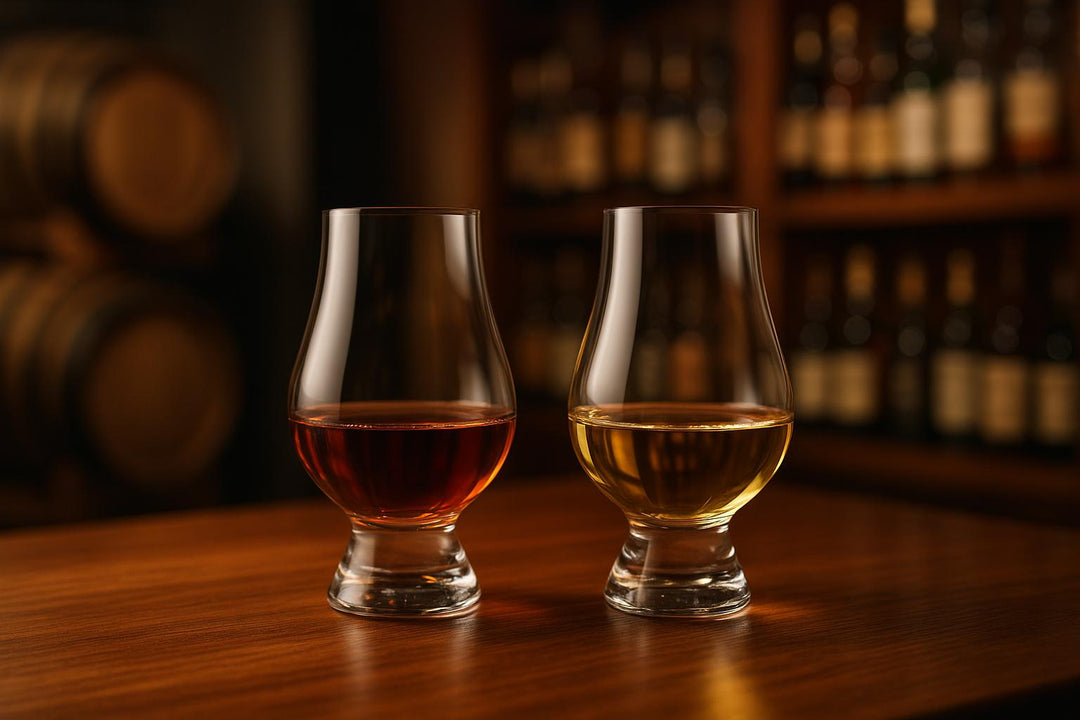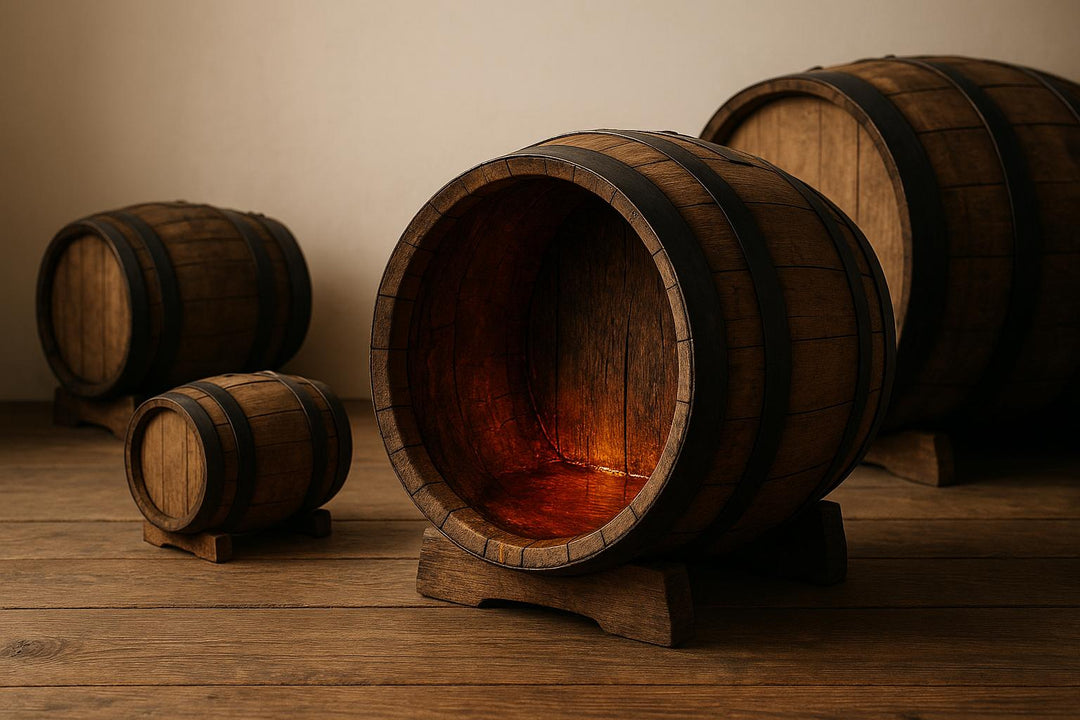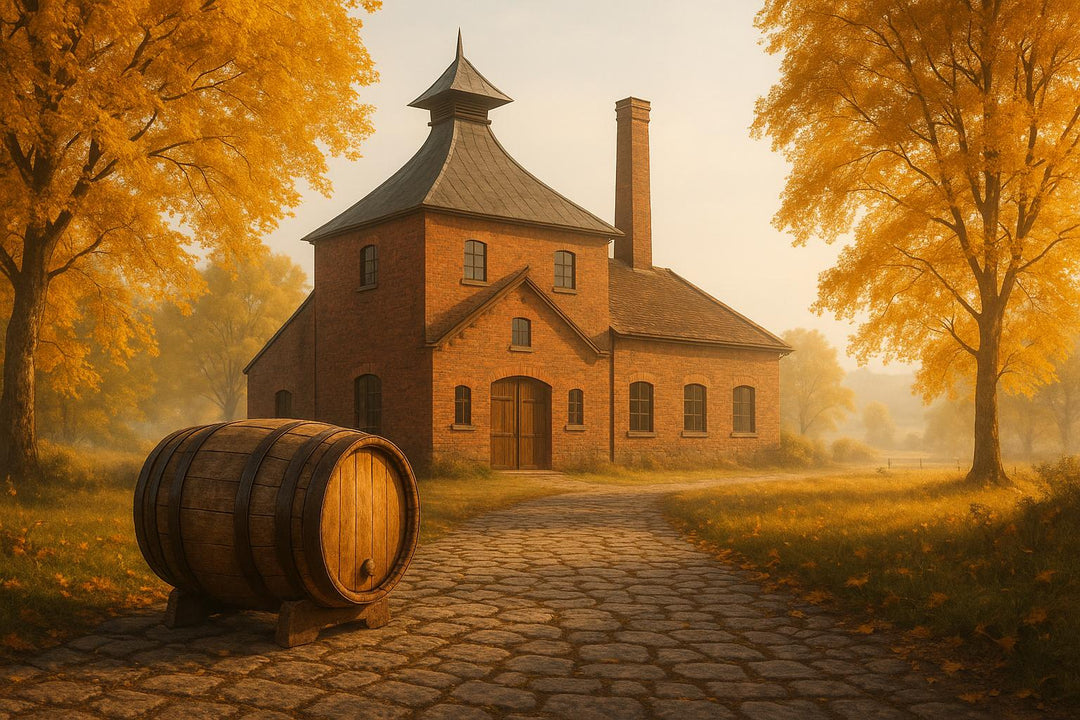Distilleries ensure whisky quality through a combination of scientific methods and expert tasting. Testing begins with raw materials and continues through production to bottling. Key methods include:
- Chemical Analysis: Techniques like gas chromatography and mass spectrometry identify flavour compounds, contaminants, and ensure accurate alcohol content.
- Sensory Testing: Expert tasting panels assess aroma, flavour, and texture to maintain consistency.
- Authenticity Checks: Advanced tools like isotope analysis and chemical fingerprinting detect tampering and verify origin.
- Batch Testing: Quality checks ensure every bottle meets standards, with problem batches corrected or repurposed.
These processes protect a distillery's reputation and guarantee a safe, consistent product for consumers.
Spirits: tasting and quality assessment
Laboratory Testing and Analysis Methods
Distilleries rely on advanced laboratory techniques to ensure their whisky meets consistent quality standards and to catch any potential issues before bottling. These methods are a vital part of the quality assurance process that supports every step of whisky production.
Chemical Analysis for Quality Control
Gas chromatography is a cornerstone of whisky analysis, helping distilleries identify and measure the many compounds that contribute to whisky's unique flavour and aroma. By separating volatile compounds based on their chemical properties, this method creates a detailed chemical profile of each batch. It's particularly useful for identifying key compounds and mapping aroma profiles, which are essential for assessing quality and authenticity [4]. The process involves heating a sample to vaporise it, then separating the compounds by their boiling points and molecular structures.
For even more precise flavour analysis, some distilleries use multidimensional gas chromatography combined with mass spectrometry and olfactometry (MDGC-MS-O). This approach can detect specific flavour compounds, including "green notes", which may signal quality concerns [4].
Mass spectrometry, often paired with chromatography, is another powerful tool. It can identify compounds with precision, detect contaminants at trace levels, and confirm flavour profiles. Routine quality checks often combine separation techniques like gas or liquid chromatography with detectors such as UV, flame ionisation (FID), or mass spectrometry (MS) [5].
Testing Alcohol Content and Purity
Accurate alcohol measurement is crucial for ensuring proper labelling, maintaining quality, and calculating taxes [7].
"The conventional and officially recognised method for determining alcohol content is the measurement of density, which can be converted to alcohol concentration using conversion tables." - METTLER TOLEDO [7]
Modern distilleries increasingly rely on digital density meters for alcohol measurement. These devices automatically calculate a liquid's density and convert it to alcohol by volume (ABV) using established conversion tables, such as those from OIML and AOAC.
| Instrument | Advantages | Disadvantages |
|---|---|---|
| Digital Alcohol Meter | Automatic measurement, built-in temperature control | Higher initial investment costs |
| Hydrometer | Simple, inexpensive | Longer analysis time, requires more sample, breakable |
| Pycnometer | Low cost, directly tied to density definition | Time-consuming, manual calculations, requires training |
For the highest accuracy, some distilleries turn to gas chromatography to measure alcohol content. This method directly quantifies alcohol molecules, offering a more precise alternative to density-based techniques [8]. When testing liqueurs or flavoured spirits, steam distillation is often preferred, as it removes interference from sugars and additives, allowing for an accurate measurement of pure alcohol content.
Checking Authenticity and Preventing Adulteration
Laboratory testing also plays a critical role in verifying whisky authenticity and preventing tampering. Distilleries use sophisticated techniques to create chemical fingerprints of their products, ensuring consistency and detecting adulteration. Principal Component Analysis (PCA) is a common tool for spotting batch inconsistencies by comparing each sample's chemical profile against established benchmarks. This can reveal subtle variations that may indicate tampering or production errors.
A notable development from the Waters Corporation and Scotch Whisky Research Institute (SWRI) involves using the Waters DART QDa with LiveID system. This method combines Direct Analysis in Real Time (DART) with mass detection (ACQUITY QDa) and multivariate statistics, achieving 100% predictive accuracy in verifying blended whisky authenticity [6].
Congener analysis examines both volatile and non-volatile compounds that contribute to a whisky's character. By identifying deviations in specific congeners, distilleries can quickly detect counterfeit products [9].
Another cutting-edge technique is gas chromatography-combustion-isotope ratio mass spectrometry (GC-C-IRMS). This method analyses the isotopic makeup of whisky components, creating a chemical signature that's nearly impossible to replicate [4].
Recent research has also shown the effectiveness of combining UV–VIS spectroscopy with partial least squares discriminant analysis (PLS-DA). This approach has achieved classification accuracies of over 98.6% for genuine samples and 93.1% for counterfeit ones [9].
These advanced laboratory methods work together to uphold the high standards that whisky enthusiasts expect. By combining rigorous testing with state-of-the-art technology, distilleries ensure that every bottle delivers on quality, authenticity, and taste.
Sensory Testing: How Tasting Panels Work
Lab testing might deliver chemical accuracy, but it’s the expert tasting panels that truly safeguard a whisky's signature character. These panels rely on skilled individuals trained to pick up subtle differences that even advanced instruments might overlook. Together, this sensory expertise and scientific precision ensure quality from production to the final sip.
The human nose, with its 400 scent receptors, can detect aromas and nuances far beyond the reach of machines [10]. This makes trained tasters indispensable for spotting off-notes, imbalances, or any variations that could alter a whisky's character [1].
Training Expert Tasters
Building a reliable tasting panel starts with rigorous training. Candidates undergo sensory tests that initially involve identifying 16 distinct aromas, later progressing to recognising these scents in diluted samples. Only those with the sharpest senses make the cut [11].
"Enthusiasm and a real interest in the field is a must." - Brian Kinsman, Master Blender, William Grant & Sons [11]
Glen Grant offers a great example of how diverse perspectives can elevate the process. They introduced a second tasting panel including team members from IT and finance departments. This approach brings fresh viewpoints while maintaining the technical standards required [11].
Training doesn’t stop at identifying flavours. Panellists also learn to refine their vocabulary, describing traits like sweetness, bitterness, saltiness, and umami. They assess mouthfeel too - whether a whisky feels smooth, creamy, viscous, or thin on the palate [13]. Regular practice builds expertise, helping tasters not only notice differences but articulate them with precision.
Kirsteen Campbell, Master Blender for The Famous Grouse and Cutty Sark, highlights the importance of this skill:
"Being on the sensory panel also provides the experience to develop the right vocabulary, so that panellists not only have the ability to notice a difference between samples, but also to pinpoint what that difference is." [11]
Keeping Flavour Consistent
Once trained, tasting panels focus on maintaining consistency across batches. They use three main methods: difference testing to spot variations, descriptive testing to map flavour profiles, and ranking to evaluate quality [11].
Sensory analysis doesn’t just measure flavour - it also examines related elements like aroma, taste, mouthfeel, colour, and appearance [12]. Panellists conduct detailed tests to ensure each batch aligns with the distillery's established standards.
These panels often collaborate with flavour and sensory science experts, blending traditional tasting skills with scientific insights to identify the subtle qualities that define a whisky’s character [14]. This partnership integrates sensory assessment throughout the production process, not just at the end [15].
To streamline their work, panels use pre-agreed language and visual aids, ensuring findings are communicated clearly and consistently [15]. This structured approach helps identify production issues early, before they reach the consumer.
An intriguing example comes from the Scotch Malt Whisky Society, which bottles single casks that often deviate from a distillery’s usual flavour profile. To protect brand identity, they introduced a coding system in 1983. As Euan Campbell, the Society’s head of whisky creation, explains:
"Quality is obviously a prerequisite. But we're also looking for something unique and curious in prospective Society whiskies – something that gets us talking." [14]
This underscores the delicate balance distilleries must strike between maintaining consistency and embracing the natural variations that make whisky so distinctive. Tasting panels play a vital role here, ensuring that while individual batches may differ slightly, they all embody the brand's essential character.
Sensory testing bridges the gap between scientific precision and the experience whisky lovers cherish. Instruments can measure compounds and concentrations, but only human tasters can evaluate how these elements come together to create the rich, complex experience that defines a great whisky.
sbb-itb-128d6c1
Batch Testing and Quality Control
After sensory and laboratory evaluations, batch testing ensures that every bottle meets stringent standards. This process combines Quality Control (QC) and Quality Assurance (QA) to maintain consistency throughout production, from sourcing raw materials to the final bottling stage [3].
"Tasting panels are 80 to 90 per cent in importance when it comes to maintaining quality standards." - Elizabeth McCall, Assistant Master Distiller at Woodford Reserve [2]
Using Reference Standards for Comparison
Distilleries use reference standards - essentially "gold standard" samples - to prevent what the industry calls "flavour drift." These benchmarks ensure that each batch preserves the brand's established flavour profile. Brown-Forman, the parent company of brands like Woodford Reserve and Old Forester, employs a team of chemists, microbiologists, and psychologists to guarantee that every bottle tastes consistent with its predecessors [2].
Their QC process starts with a detailed grain inspection, including sensory evaluations and visual checks of incoming materials. Proprietary yeast strains are preserved in cryogenic freezers at -80°C across multiple locations to maintain genetic consistency. Once thawed, these cultures are tested for viability and bacterial contamination before use [2]. During production, advanced analytical tools monitor the molecular composition of distillates, while routine barrel sampling during maturation ensures that the final product aligns with the brand’s flavour standards [2]. This meticulous system links laboratory precision with product integrity.
Managing Problem Batches
If a batch doesn’t meet the required benchmarks, corrective actions are taken. Common solutions include blending with compliant batches or setting aside inconsistent products to safeguard brand integrity [2].
One notable example of this occurred at Brown-Forman during the production of a special rye malt for Woodford Reserve’s limited edition Master's Collection. Following this run, the next distillate - produced on the same pot stills - was flagged by tasting panels for an unusual flavour profile. The batch had absorbed flavour notes from the previous limited-edition production [2].
This incident underscores the importance of maintaining detailed records of production, ingredient sourcing, and quality control procedures. Such documentation is vital for compliance during audits and inspections [3]. Lot traceability is particularly critical, enabling distillers to track raw materials and production stages to ensure consistency across multiple batches [16].
"QC involves direct inspection and measurement of the product against set specifications. In distilling, this might include testing alcohol levels, assessing flavour profiles, and ensuring clarity and purity. Quality Control is the frontline defence against quality issues – it sets a pass / fail metric with defined goal posts." - Everglow Spirits [3]
When problem batches arise, some distilleries choose to re-purpose substandard whisky. For instance, it may be sold for re-distillation into industrial alcohol. Michael R. Veach from Stitzel-Weller notes:
"The effort made by this Quality Control team is part of the reason that Stitzel-Weller whiskey enjoys its great reputation. Believe me, there were bad barrels of whisky that ultimately ended up being sold for re-distillation into alcohol for the fuel industry." - Michael R. Veach [17]
Modern distilleries increasingly adopt Quality Management Systems (QMS) to streamline operations, minimise errors, and ensure batch consistency [3]. These systems, often supported by specialised distillery management software, allow precise tracking of raw materials and finished products [16].
The Really Good Whisky Company's Quality Standards

The Really Good Whisky Company takes whisky seriously, applying meticulous care to every aspect of their selection and service. Much like the distilleries that craft these spirits, they maintain uncompromising standards to ensure only the finest whiskies make it to their customers. From sourcing rare gems to offering tailored advice, their dedication shines through every step of the process.
Selecting Premium Whiskies
At the heart of their approach is a dedication to sourcing rare and limited-edition whiskies that showcase exceptional craftsmanship. Their team of whisky enthusiasts scours the market for unique bottles that are hard to find elsewhere. This careful selection process reflects the rigorous quality checks employed by top-tier distilleries and has earned them a loyal community of over 30,000 whisky aficionados [18]. For members of the exclusive Really Good Club, their London boutique offers an added perk: the chance to sample new and limited releases before making a purchase.
Custom Bottling and Labels
The company also goes a step further with bespoke bottling and personalised labels, making their offerings ideal for corporate gifting [18]. Every custom bottle is handled with care to ensure the whisky’s quality remains intact, while the labels are tailored to meet individual preferences. Their attention to detail extends to shipping as well. They pack each bottle with exceptional care, ensuring it arrives safely and in perfect condition, no matter where in the world it’s headed. Every shipment is fully insured for added peace of mind [18][19].
Expert Selection for Whisky Lovers
For whisky enthusiasts, the company’s expert team provides personalised recommendations to help customers discover bottles that match their tastes. This commitment to quality and customer satisfaction is reflected in their "Excellent" rating of 4.5/5, based on 96 reviews [20]. They also cater to a global audience, shipping to regions where local regulations permit [19]. The London boutique further enhances this experience, offering a hands-on opportunity for customers to explore and feel confident in the quality of their chosen whiskies.
Conclusion
Key Points
From the raw ingredients to the final pour, whisky undergoes meticulous testing to ensure it meets the highest standards. Distilleries rely on a combination of chemical analysis and sensory evaluation to strike the perfect balance between scientific precision and traditional craftsmanship that defines great whisky[1]. These tests - whether in the lab or through sensory assessment - ensure that every sip is not only safe but also embodies the signature character that whisky lovers expect[1].
As Jeff Arnett, former Master Distiller at Jack Daniel's, explains: "Quality touches everything at Jack Daniel, so it's not something that we try to police into the end of the process" [21]. This philosophy is reflected in the way premium distilleries weave quality assurance into every step of production.
Even the high-speed bottling lines, designed for efficiency, maintain an extraordinary level of consistency with minimal errors or complaints[21]. This impressive reliability is a direct result of robust testing protocols that address potential issues long before they reach consumers.
These practices highlight how deeply quality is embedded in every stage of whisky-making, reinforcing its critical role in the world of premium whisky.
Quality's Role in Premium Whisky
Beyond testing, quality is the backbone of premium whisky production. In a global market worth billions[9], consumer trust hinges on consistent excellence. Every bottle must deliver the same outstanding experience, whether it’s the first or the millionth from a batch. This rigorous process ensures that each bottle meets regulatory standards, maintains consistent flavour, aroma, and appearance, remains free of harmful substances, honours its age and origin claims, and delivers the same premium experience every time[1].
This dedication to quality builds consumer confidence and reflects the values discussed throughout this article. The Really Good Whisky Company upholds these same principles in their selection process, offering expertly curated bottles. Whether you're exploring a rare single malt or sampling a whisky tasting pack, their commitment ensures every product has passed through multiple layers of scrutiny.
FAQs
How do distilleries verify the authenticity of their whisky?
Distilleries go to great lengths to ensure their whisky is genuine and upholds top-notch standards. They rely on chemical testing to break down and examine the spirit's composition, while also meticulously inspecting bottle seals and labels for any signs of tampering. Additionally, they cross-check official distillery records, such as warehouse receipts, to confirm the whisky’s origin.
In the fight against counterfeiting, advanced scientific tools like spectral analysis and laser-based techniques play a vital role. These methods not only spot fakes but also verify the whisky’s authenticity and origin. Such thorough measures safeguard the whisky’s flavour, maintain its quality, and uphold the reputation of the brand - giving whisky lovers confidence in every sip.
What is the role of tasting panels in ensuring whisky quality?
Tasting panels are key to ensuring whisky maintains its quality and consistency. These teams, made up of skilled experts, rely on their finely tuned sensory abilities to examine the whisky’s aroma, flavour, and texture.
Through meticulous evaluation of each batch, they confirm that the whisky aligns with the distillery's established standards and signature profile. Additionally, tasting panels can detect minor imperfections or issues that other testing methods might miss, playing an essential role in preserving the product's overall excellence.
Why do distilleries use gas chromatography to measure alcohol content in whisky?
Distilleries rely on gas chromatography to determine the alcohol content in whisky due to its precision and efficiency. This method works by separating and analysing the whisky's components, enabling an exact measurement of ethanol levels.
What makes gas chromatography stand out is its speed, sensitivity, and dependability. It's a go-to tool for quality control and plays a key role in ensuring flavour consistency. By using this technique, distillers can uphold the high standards whisky lovers expect while retaining the distinctive qualities of every batch.






Leave a comment